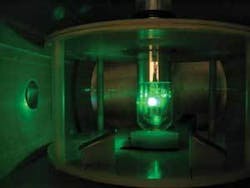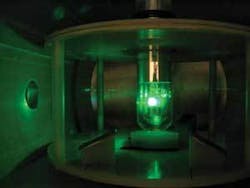Optical detection enhances NMR imaging
Researchers from Princeton University (Princeton, NJ) have found that polarized light from a solid-state laser can significantly improve the resolution and sensitivity of nuclear magnetic resonance (NMR) and could lead to real-time 2-D imaging of liquid samples. According to Michael Romalis and colleagues in the Princeton Dept. of Physics, NMR is typically detected by recording the net dipolar magnetic field outside a spin-polarized sample; however, the recorded bulk of the magnetic field provides only limited spatial or structural information about the sample. Most NMR applications thus rely on complex techniques such as magnetic-field-gradient encoding or spin-correlation spectroscopy to enhance the information that is gleaned from a sample.
Using optical NMR detection, however, Romalis has found that the rotation of light polarization by nuclear spins is readily measurable and even enhanced in samples containing heavy nuclei. His technique-dubbed nuclear-spin optical rotation-involves shining a plane-polarized 1064 or 532 nm beam from a diode-pumped solid-state laser or a 770 beam from an external-cavity diode laser at a sample and measuring the optical rotation signal-that is, the overlap between the nuclear spin and the virtual electron excitation created by the laser. The experimental setup is simple and works with all liquids and, potentially, transparent solids. Initial applications will likely be in spectroscopy, in which the technique could be adapted using different wavelengths and the amount of rotation is dependent on the molecular species and the interaction of the nuclear spin with the laser. The next step is to explore using a light-build-up cavity to get a bigger signal or a hollow fiber filled with fluid. Contact Michael Romalis at [email protected].

